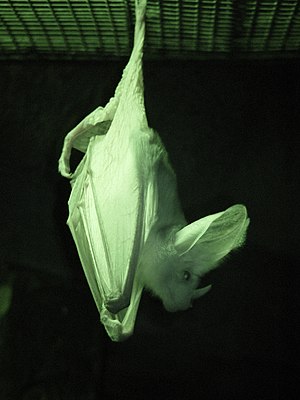Australian ghost bat
| Australian ghost bat | ||||||||||||
|---|---|---|---|---|---|---|---|---|---|---|---|---|

Ghost bat in Perth Zoo , infrared image |
||||||||||||
| Systematics | ||||||||||||
|
||||||||||||
| Scientific name of the genus | ||||||||||||
| Macroderma | ||||||||||||
| Miller , 1906 | ||||||||||||
| Scientific name of the species | ||||||||||||
| Macroderma gigas | ||||||||||||
| ( Dobson , 1880) |
The Australian ghost bat ( Macroderma gigas ) is a species of bat from the family of large-leaf noses (Megadermatidae). It is considered to be the largest bat in the world (not to be confused with the largest bat , as some fruit bats become significantly larger.)
distribution
These animals live in northern Australia , Western Australia , the Northern Territory and the coastal regions of Queensland . Their range is large, but fragmented.
description
Australian ghost bats reach a head body length of 10 to 14 centimeters, a wingspan of up to 60 centimeters and a weight of 130 to 220 grams. Their name comes from the color of the fur, which is gray on the top, while the face, ears, wings and underside are colored white. The ears are very large and connected with a skin band at the base, the tragus is well developed and divided. The nasal blade protrudes upwards. Like all large-leaf noses, they have a well-developed tail flight membrane, but no tail.
Way of life
These bats inhabit both arid regions and rainforests in northeast Australia. They sleep in caves, crevices or old mines, usually alone or in small groups. In the evening they go in search of prey by hanging from a tree and lurking there for prey . Their main food is mice , but they also hunt other rodents , small marsupials , other bats, birds , lizards and insects . Their prey is killed with a bite in the neck and then taken to an elevated point or back to the hunters' den where it is consumed.
Reproduction
The mating season falls in winter (July to August), the gestation period is around three months. For birth, which falls between September and November, the females retreat to nurseries. The mostly single young animal is initially carried by the mother, later left behind in the sleeping place. From the seventh week of life it begins to learn to fly and goes hunting with its mother. They are weaned at around six months and sexually mature in their second year of life. The highest known age of an animal in human care was 16 years.
threat
Hundreds of years ago, Australian ghost bats were found all over Australia, then their range began to retreat northwards, a trend that has intensified since the arrival of Europeans. The reasons for this decline are not entirely clear; it is assumed that the fundamental change in agriculture and the associated loss of prey may be behind it.
The current level of risk is also not easy to assess, mainly due to the shy way of life. Estimates of the total population amount to 6000 to 10,000 animals, which live in several areas. The largest group lives in a mine system near Darwin and is threatened by a planned intensification of prospecting activities. Overall, the species is listed as endangered.
literature
- Ronald M. Nowak: Walker's Mammals of the World. Johns Hopkins University Press, 1999, ISBN 0801857899
Web links
- Macroderma gigas inthe IUCN 2013 Red List of Threatened Species . Posted by: McKenzie, N. & Hall, L., 2008. Retrieved December 28, 2013.